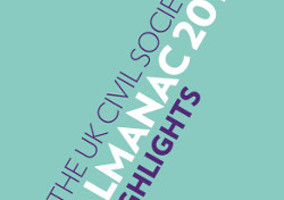Kirsty Weakley takes a closer look at some of the findings from this year's UK Civil Society Almanac.
NCVO’s latest UK Civil Society Almanac paints a cautiously optimistic picture. For the second year in a row income has gone up slightly, to just over £45bn, with earned income rising and income from government seeming to level off.
Sector spending, workforce and reserves also rose modestly. So the overall picture the Almanac paints is one of stability – basically not much has changed from last year.
I’m not sure many people would have been expecting to see rapid growth, but the absence of widespread decline should be reassuring.
In 2011/2012 and 2012/13 the sector’s income fell in real terms and NCVO’s chief executive, Sir Stuart Etherington, warned that the sector had been “running to stand still”.
So two years of growth, even modest growth, could be seen as something to celebrate.
Everything has changed
But of course this data refers to accounts for the year ending March 2015, which now feels like a very long time ago. The reason it takes a while is that charities have ten months to file accounts with the Charity Commission and then the researchers at NCVO need some time to analyse it.
Firstly this means that any fallout from fundraising scandals of the summer 2015, where several large charities were criticised for treating donors badly, is yet to be captured by the almanac.
Secondly in March 2015 Brexit wasn’t even a word let alone a reality, the then Chancellor George Osborne had just announced that the UK economy had the fastest annual growth among the G7 countries, and Nick Clegg was still Deputy Prime Minister.
Since then the UK has arguably become considerably more chaotic and with another general election looming next month you’d be hard pushed to find anyone in the sector who would characterise the current situation as stable.
Something which Etherington acknowledges in the introduction. “This 16th edition of the UK Civil Society Almanac is published in uncertain times. The decision to leave the European Union, a new government and wider global changes will fundamentally alter our country’s economic, political and social landscapes,” he writes.
So two years ago we now know that things were looking up, but the behaviour of parts of the sector and changes in the political landscape.
Donation stagnation
NCVO also warns the sector that challenging times ahead mean growth in donations is unlikely, as Brexit begins to bite and households feel the pinch.
The area that NCVO highlights as a potential for growth is in earned income – this includes fees for their services and income selling goods or services to raise money.
Between 2007/08 and 2014/15 earned income from individuals grew by 35 per cent from £7.74bn to £10.45bn.
Realistically NCVO advises that this looks like the only growth area for the sector’s income and Etherington says “this is a trend that will have to continue if the sector is to see growth in the next few years”.
Of course being entrepreneurial is easier for some charities than others. Some causes or campaigns lend themselves better to it. It’s also harder for smaller charities with limited skills and resources to be entrepreneurial.
Charities will need to learn from each other and, as Lord Lupton said recently, look at how best to pool resources and collaborate.
Growth is uneven
We should also note that just because there has been a small rise for the general sector for many reasons this won’t be the experience for many charities, especially those on the frontline many of which are seeing demand for services increase.
Overall government income for the sector rose slightly, from £15.1bn to £15.3bn, though it is still below 2009/10 levels when it was £15.7bn. Over 80 per cent of this was earned through contracts or fees.
It is also somewhat concerning that for the first time in a decade central government funding is higher than local government funding, which has fallen to £7.1bn.
There were also shifts in how government funding is shared out in the sector, with the largest charities taking a larger share of the pot.
This is the second year that NCVO has included super-major charities – those with incomes over £100m as a separate category, and it is these charities which have benefited the most from government income.
Super-major charities saw their government income increase by 9 per cent, while those in the next category down, £10m to £100m, actually saw it fall by 2 per cent, large charities saw no change and small and medium sized charities saw small increases in their percentage of government income.
What next?
With the continued pressure on small and local charities and relatively few avenues for growth it is easy to see why NCVO is suggesting that the government should use the £2bn dormant asset windfall to endow community foundations and help communities to buy local assets.
How receptive the next government will be to this remains to be seen. There is always the risk that community foundations, many of which have been around for a long time, are viewed as too old-fashioned and the government could instead try to create something new (but then again it could be too busy with Brexit to bother).
Ultimately this year’s Almanac shows that while there was some cause for optimism, some parts of the sector were still fragile. Unfortunately events that took place shortly after the time the Almanac covers, and which have created a more uncertain and unstable environment means it’s difficult to make too many predictions.
Related articles












